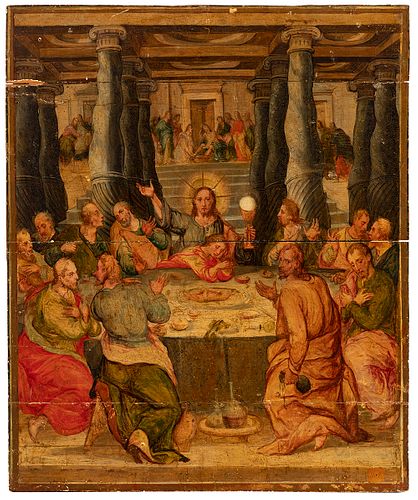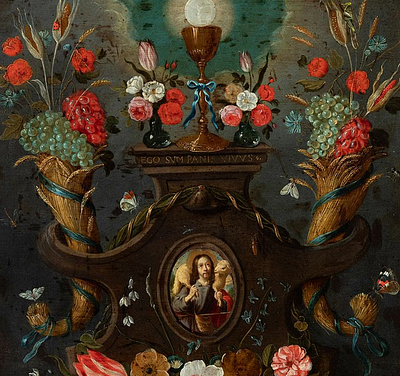Spanish school; second half of the 17th century. "Last Supper". Oil on panel.
Lot 36
About Seller
Setdart Auction House
Carrer Aragó 346
Barcelona
Spain
Setdart Subastas was born in 2004 and is currently the first online art auction in Spain with solidity, prestige and reliability guaranteed by our more than 60,000 users. Setdart has a young, dynamic and enterprising team ready to successfully manage the purchase and sale of art works through custom...Read more
Estimate:
EUR€5,000 - EUR€6,000
$5,263.16 - $6,315.79
Absentee vs Live bid
Two ways to bid:
- Leave a max absentee bid and the platform will bid on your behalf up to your maximum bid during the live auction.
- Bid live during the auction and your bids will be submitted real-time to the auctioneer.
Bid Increments
| Price | Bid Increment |
|---|---|
| EUR€0 | EUR€10 |
| EUR€200 | EUR€25 |
| EUR€500 | EUR€50 |
| EUR€1,000 | EUR€100 |
| EUR€3,000 | EUR€200 |
| EUR€5,000 | EUR€500 |
| EUR€10,000 | EUR€1,000 |
| EUR€20,000 | EUR€2,000 |
| EUR€50,000 | EUR€5,000 |
About Auction
By Setdart Auction House
Sep 21, 2021
Set Reminder
2021-09-21 10:00:00
2021-09-21 10:00:00
America/New_York
Bidsquare
Bidsquare : 21st September - ARAS JÁUREGUI Private Collection - Old Masters, 19th & 20th Century
https://www.bidsquare.com/auctions/setdart-auction-house/21st-september---aras-j-uregui-private-collection---old-masters-19th-20th-century-7429
Setdart Auction House sofia@setdart.com
Setdart Auction House sofia@setdart.com
- Lot Description
Spanish school; second half of the 17th century. "Last Supper". Oil on panel. It presents damages and xylophagous remains. Measurements: 83 x 69 cm. The author has chosen to represent here, as Castagno, Leonardo and Jacopo Bassano did, the most dramatic moment of the Last Supper, when Jesus announces that one of his disciples will betray him (John 13:21). This statement causes consternation among the twelve followers of Jesus, and this is the moment that the author depicts, trying to reflect the feelings of each one, individualising the characters; some are astonished, others are frightened, others comment among themselves on the news, and finally Judas is surprised to feel alluded to, clearly showing the viewer the bag of coins with which they have paid for their betrayal, which he holds behind his back, hiding it from his companions. As is traditional in the religious art of the high period, Judas is depicted with red hair, then associated with evil in popular belief. Apart from him, two other disciples attract our attention. Firstly, John the Evangelist, "the beloved disciple", is shown in deep consternation, lying dejectedly on the table, bowing his head in grief. Also prominent is the figure of Saint Peter, situated to the right of Christ as the future pillar of his Church, who holds his hand to his chest. The classical composition for this theme in the 16th century depicted Judas in front of the table and the other eleven apostles in front of him, with Jesus Christ in the middle as one of them. However, following a more advanced iconographic model, the author includes Judas in the group, although he is clearly highlighted on the right side. In addition, as is typical of the school, the scene is painted with great attention to detail, with the painter having treated the anecdotal elements that add narrative to the scene with precision and meticulousness, such as the basin in the foreground and the foodstuffs on the table. It should be noted that the work not only depicts the moment of the Last Supper, but in the background, behind the Solomonic columns, another space can be seen where all the apostles are gathered together with the figure of Jesus. Jesus is kneeling, washing the feet of one of his disciples, an event that took place prior to the supper (John 13:20). This gesture demonstrated both Christ's hospitality and humility towards his apostles. The image of this Last Supper in the foreground of the composition is inspired by the scene painted by Giorgio Vasari, which is in the collection of the Museo di Santa Croce in Florence. Despite the obvious differences between the two works, it should be noted that the arrangement of both Jesus, with his raised hand, and Saint John, who lies on the table, are common to both works. The rest of the table, however, differs, being in this case a more centripetal, or perhaps less rationalised, composition. Furthermore, the interior in which Vasari's scene is set is completely austere, while here it is notable for its profusion of detail, as mentioned above.
- Shipping Info
-
In-house shipping available. Please inquire at admin@setdart.com.
-
- Buyer's Premium



 EUR
EUR CAD
CAD AUD
AUD GBP
GBP MXN
MXN HKD
HKD CNY
CNY MYR
MYR SEK
SEK SGD
SGD CHF
CHF THB
THB

















